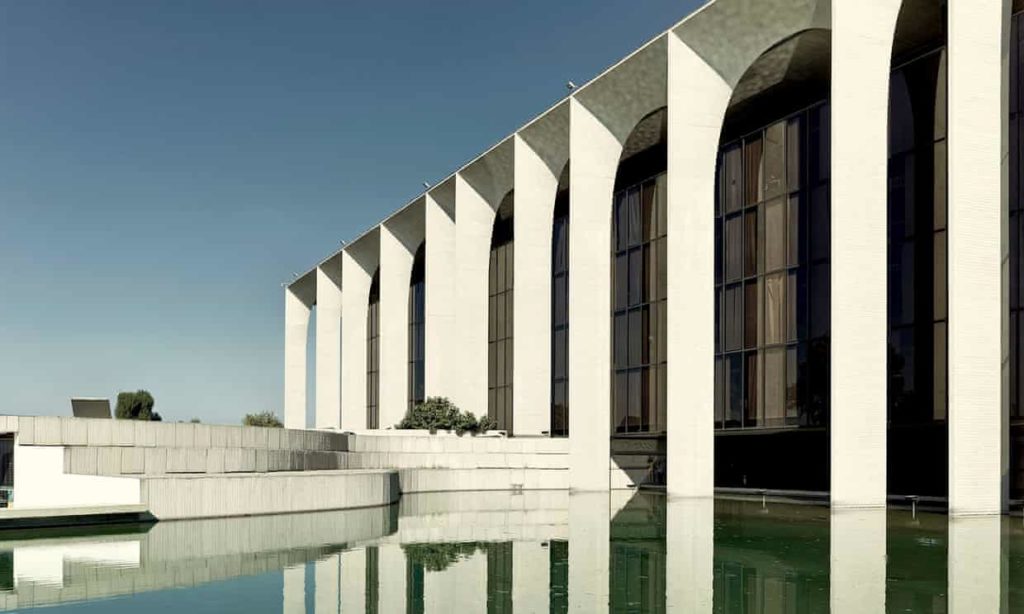Literary lockdown: how translating a Dan Brown novel made for a thriller plot

When The Da Vinci Code author’s next novel needed simultaneous translations in 2013, what happened next was extraordinary enough to inspire a film of its own
In March 2013, Carole Delporte, a 37 year-old French translator, flew to Milan on a job for which she had been carefully screened, and finally selected. Only her husband and two young daughters back home in Paris were allowed to know where she had gone.
After checking into her hotel, Delporte made her way to an imposing modernist building in an industrial sprawl on the outskirts of the city. When she arrived, she was led to the basement, where two security guards put her phone and handbag in a locker. She then entered a large room where a team of 10 people from six different countries were typing away. For the next two months, Delporte would work here in total secrecy to translate Inferno, the then-unpublished fourth Robert Langdon novel by bestselling US author Dan Brown.
Coming out 10 years after Brown’s The Da Vinci Code became one of the bestselling books of all time, Inferno followed Langdon, the Harvard professor of “symbology” who decodes intricate religious mysteries to stop catastrophic events – in this case a lethal pandemic.
But it is the extraordinary experience of Brown’s translators that has now inspired a film: Les Traducteurs, by French director Régis Roinsard. In Roinsard’s film, 10 pages of the novel (retitled Dedalus) are leaked and the translators are put up against the clock to find the source. In reality, the 11 translators in the Milanese bunker had just one job: translate Inferno, and guarantee the simultaneous publication of the novel worldwide.
The secretive location that Delporte found herself in was the headquarters of Gruppo Mondadori, Italy’s largest publishing house. Since 1975, the company has been housed in an iconic building designed by Brazilian architect Oscar Niemeyer: a concrete structure made up of a series of sculptural arches and black tinted windows that emerges from a 20,000-sq-metre lake. “It was a bit like working in a crisis unit,” says Delporte. “We were under time pressure, and we had to do a top-class job. You mustn’t forget that it will be read by millions of people.”

‘We were under time pressure, and we had to do a top class job’ … Oscar Niemeyer’s Mondadori building in Segrate, outside Milan, where Inferno was translated. Photograph: Mondadori Portfolio/Getty Images
Unlike in Roinsard’s film, the “bunker” was not a luxurious doomsday shelter. Instead, it was a large conference room, equipped with a coffee machine, fridge, microwave and a printer. Despite being a basement, Delporte remembers it as comfortable, with two big windows providing some natural light and, in an Olympic Games-like gesture (that does feature in Roinsard’s film), a little flag on each desk indicating the various languages involved: Spanish, Italian, French, German, Portuguese and Catalan.
While some agile translators worked individually, most tackled the 3,000 manuscript pages in pairs. Delporte, who had been hired by the French publishing house JC Lattès, worked with Dominique Defert, with whom she had already translated other bestsellers including Walter Isaacson’s biography of Steve Jobs. “You need people who are psychologically strong,” says Delporte. “Working in a bunker for a month and a half is a very unusual experience.”
The aim was to avoid a catastrophic leak. Five years before, Twilight author Stephenie Meyer scrapped the fifth book in her bestselling vampire series, Midnight Sun, after an unfinished draft found its way online. Armed security personnel guarded the bunker entrance around the clock. Internet access was cut off. The translators’ laptops could never leave the room. To research online (essential with Brown’s books), the translators had to share four other computers that were connected to the internet and make their notes by hand. Their hard copies of the English manuscript were locked in a safe at night. Trips to the bathroom were logged by the security guards.
The translators were under strict orders not to speak to anyone in the office canteen about their work, especially not the Mondadori employees, some of whom were journalists. “We had to guarantee that the contents of the book would not be at the disposal of anybody outside that room,” says Francesco Anzelmo, Mondadori’s editorial director.
In a corner of the room was a whiteboard where they could write down questions that would be passed on to Brown. “We all asked ourselves the same questions, so it was good because we could discuss them together,” says Delporte. Did a market’s opening hours correspond with the time of day the action takes place? Was it possible to shoot at someone from that angle on the stairway? “He must have thought: ‘These translators are crazy!” says Delporte. “But in a way we were his first readers.”
This type of literary lockdown was not only taking place in Italy. In London, the Dutch, Norwegian, Swedish, Danish and Turkish translators underwent a similar experience in the basement of Transworld Publishers, a division of Penguin Random House. “We had everything we needed. The only thing we didn’t have was internet,” says Turkish translator Petek Demir İncek. “We had to sign an agreement saying that we would pay a big penalty fee if we told anyone what we were doing.” The reason for splitting the translators into two groups provided another layer of security, says Anzelmo: “The fewer people in the same room, the fewer possibilities of anything getting out.”
International settings made Brown’s novels particularly suited to the new strategy. Inferno sees Langdon travel from Florence to Venice to Istanbul, while Origin mostly takes place in Spain. “Inferno was particularly important for us because it was set in Italy,” says Anzelmo. “We felt more involved in the book for national and cultural reasons.”
The operation conceived for Inferno was the first of its kind. Usually the translation of Brown’s novels started after the English edition was already on the bestseller list, leaving European publishers to scramble to get their versions into shops. That had been the case with The Lost Symbol, the hotly anticipated sequel to The Da Vinci Code, which came out after two blockbusters starring Tom Hanks had already attracted huge global audiences. While The Lost Symbol broke first day sales records in the US, UK and Canada, the first translations – Italian, Spanish and French – didn’t arrive until a month later.

Highly symbological …Dan Brown at the Berlin premiere of the film version of Inferno in Berlin. Photograph: Markus Schreiber/AP
Annamaria Raffo, one of the three Italian translators in the bunker, has translated authors such as Ken Follett and Robert Harris during her more than 30-year career. Before translating Inferno, she had worked in a five-strong team to get the Italian version of The Lost Symbol finished in under two weeks. “Despite working very quickly, we lost those 15 days,” says Raffo. “In the meantime, some readers bought the book in English because they couldn’t wait.”
By the time Inferno was announced, it was obvious European editions had to launch at the same time as the English version, especially at a time when buying the book in English had never been easier. “Nowadays, from the moment it’s out in the US or the UK, you can order it on Amazon and have it in a couple of days. That wasn’t the case 20 years ago,” says Anzelmo. This is even truer in countries such as Holland, where a widespread knowledge of English poses a real challenge. “It’s much more important now to publish the translation simultaneously.”
In 2017, publishers decided to do it again for Origin, Brown’s fifth novel in the Langdon series. This time, 26 translators gathered in Barcelona, where part of the novel is set. The event was organised by Grupo Planeta, the leading publishing group in Spain and Latin America. “With Origin, the operation was further perfected,” says Raffo. This time, translators who had been in Milan and London were in the same room. Security was reinforced and no one was allowed to bring their own laptops. Instead of a basement, they were now in a windowless room on the fifth floor of Planeta’s offices, and totally isolated. Raffo remembers the air conditioning constantly being on full blast. “In Milan it was called the bunker and in Barcelona we called it the igloo,” she says.
“It was a bit of a culture shock,” says Delporte, in terms of agreeing working hours. The Nordics wanted to start at 8am, while the Mediterraneans preferred waking up late and working into the evening. As a group of freelancers used to the comfort of their homes, they had to adapt to new conditions. “It brought together a bunch of hermits, each with our own habits,” says Claudia Conde, one of the Spanish translators. “So working together was quite strange. It was an extraordinary situation.”
Ultimately, the team effort paid off. When Inferno was published in May 2013, it sold more than 50,000 copies in Italy in its first 24 hours. In Spain, Origin quickly sold out and, after an initial print run of 600,000 copies, both Mondadori and Planeta announced an additional 100,000 to meet demand among Italian and Spanish readers.
In Les Traducteurs, the translators are transformed into figures akin to secret agents as they hunt for the source of the leak. The skills of Delporte and her peers have never seemed so glamorous. “It’s interesting to have made a film about our profession,” she says. “It’s good because it sparks a discussion about our job.”
In many ways, it is the opposite of what the translators signed up for when they chose their solitary, behind-the-scenes line of work. A Greek translator in Roinsard’s film declares: “If I had wanted to work in an open-plan office, I wouldn’t have chosen this profession.”
But in reality, a certain esprit de corps grew from the experience. “Few translators can claim to have all worked together on the same text,” reflects Raffo. “It was nice to be able to exchange ideas,” says Demir İncek. “It’s usually a lonely job.” Being able to solve problems together and explain the novel’s many historic and cultural references to each other was an experience that many found liberating, despite being confined. “They were two months of suffering,” sighs Raffo. “But I would do it again tomorrow.”